Easy Slow Cooked Oven Brisket Recipes
Dive into the world of the best oven brisket recipe! Why should you consider the oven for your next brisket? Simple: it combines utter simplicity with delicious results.
Ideal for anyone looking to minimize fuss and maximize flavor, making slow cooked brisket in oven means you can set it and forget it, letting the slow heat do all the work.
This method guarantees a brisket that’s not only succulent and tender but also consistently delightful. Get ready to explore how oven-cooked brisket can transform your cooking experience from tedious to effortless.
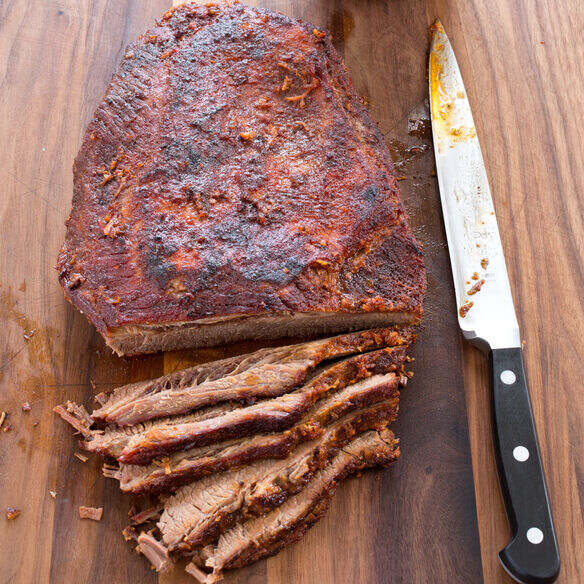
Why This Recipe Works
This oven brisket recipe excels for several reasons:
- Mimics Smoking: The oven can replicate the gentle, consistent heat necessary for smoking, allowing the brisket to absorb flavors deeply and evenly.
- Controlled Cooking Environment: Unlike outdoor cooking, the oven provides a controlled environment, eliminating variables such as wind and temperature fluctuations. This consistency is key for perfect brisket every time.
- Ease and Accessibility: Oven cooking doesn’t require special equipment like a smoker, making it accessible to everyone. It’s about bringing smoking techniques into every home kitchen.
- Flavor Development: The slow cooking process in the oven allows for a full development of flavors, resulting in a brisket that is both flavorful and tender, with a perfect crust that rivals traditional smoking.
Selecting the Right Brisket
Choosing the correct cut of brisket is crucial for achieving the best results. Here’s what you need to know:
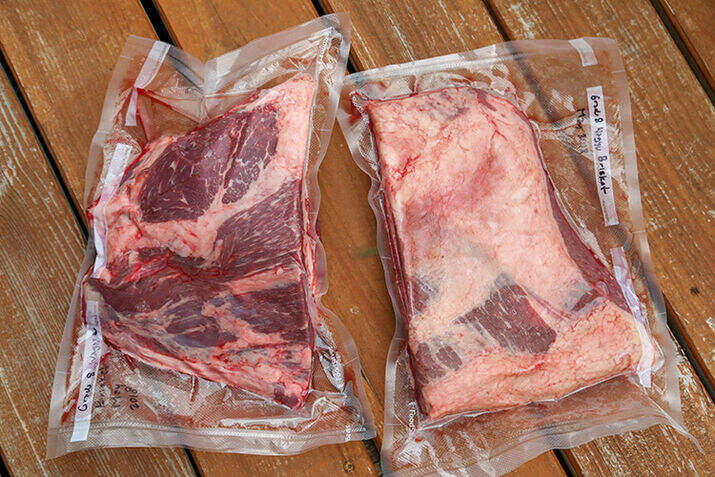
Understanding the Cut: What meat is used for brisket? Brisket comes from the lower chest or breast of beef. This area is typically worked hard, resulting in more connective tissues and a denser texture that becomes incredibly tender when cooked slowly.
Flat Cut Beef Brisket: Opt for the flat cut beef brisket if you prefer a leaner option that cooks evenly and slices beautifully. It’s ideal for those who want a balance between tenderness and a meaty texture.
Beef Belly Brisket: Alternatively, beef belly brisket includes more fat, which can enhance flavor and tenderness throughout the cooking process. This cut is perfect for those who crave that melt-in-your-mouth texture.
Size Matters: Aim for a brisket that’s around 10 to 12 pounds. Larger cuts ensure a good balance of meat and fat, essential for maintaining moisture and flavor during the long cooking hours in the oven.
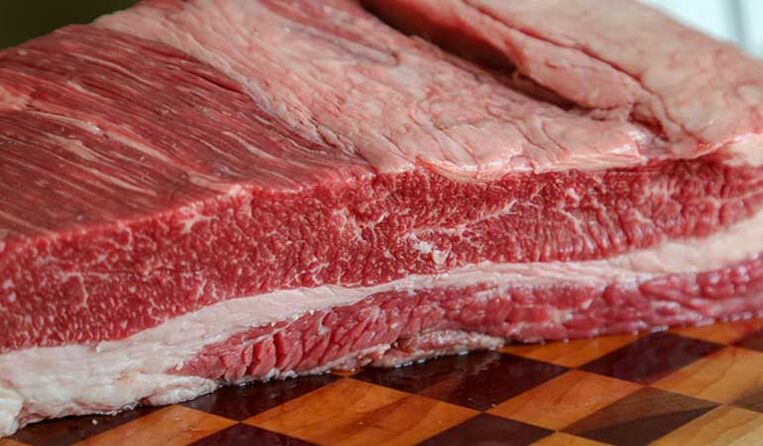
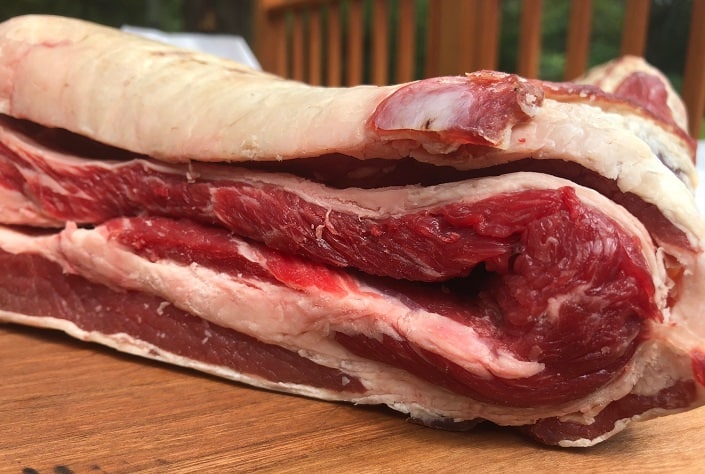
Marinating the Brisket
Marinating your brisket is not just about adding flavor; it’s also about tenderizing the meat to ensure it’s perfectly succulent. Here’s how to get the most out of this crucial step:

- Timing is Key: For optimal results, marinate your brisket for at least 12 hours. This lengthy process allows the flavors to deeply penetrate the meat. If time allows, extending the marination to 24 hours can enhance the flavor and texture even further.
- Flavor Profiles: Choose a marinade that complements the rich flavors of the brisket. Ingredients like Worcestershire sauce, garlic, onion, and smoked paprika add depth, while a touch of sweetness from brown sugar or honey balances the robust taste.
- Technique Tips: Ensure the entire brisket is evenly coated with the marinade. Using a resealable bag or large dish, turn the brisket several times during the marinating process to distribute the flavors evenly.
- Beyond the Basics: Consider introducing acidic components like vinegar or citrus juice to the marinade. These can help break down tough muscle fibers, further tenderizing the meat without compromising its structure.
Ingredients Needed for Slow Cooked Brisket in Oven
To ensure your brisket is flavorful and tender, you will need the following ingredients for the marinade and dry rub:
For the Marinade:
- 1 cup apple cider vinegar — adds a tangy base that helps tenderize the brisket.
- 1/2 cup soy sauce — brings depth with its salty, umami flavor.
- 1/4 cup brown sugar — balances the marinade with a touch of sweetness.
- 1/4 cup Worcestershire sauce — enhances the meaty flavor with its complex profile.
- 3 cloves garlic, minced — adds a sharp, aromatic touch.
- 1 tablespoon smoked paprika — introduces a subtle smokiness.
- 2 teaspoons black pepper — provides a nice heat.
- 1 teaspoon salt — crucial for seasoning and moisture retention in the meat.
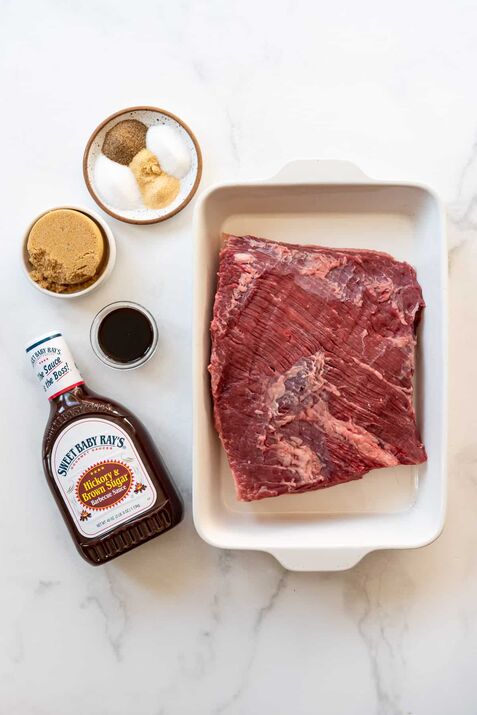
For the Dry Rub:
- 1/4 cup coarse salt — forms the crusty exterior and seasons the meat.
- 1/4 cup black pepper — for a peppery crust.
- 2 tablespoons garlic powder — for a consistent garlic flavor.
- 2 tablespoons onion powder — adds sweetness and depth.
- 1 tablespoon chili powder — introduces a mild heat and color.
- 1 tablespoon mustard powder — offers tanginess and binds other flavors together.
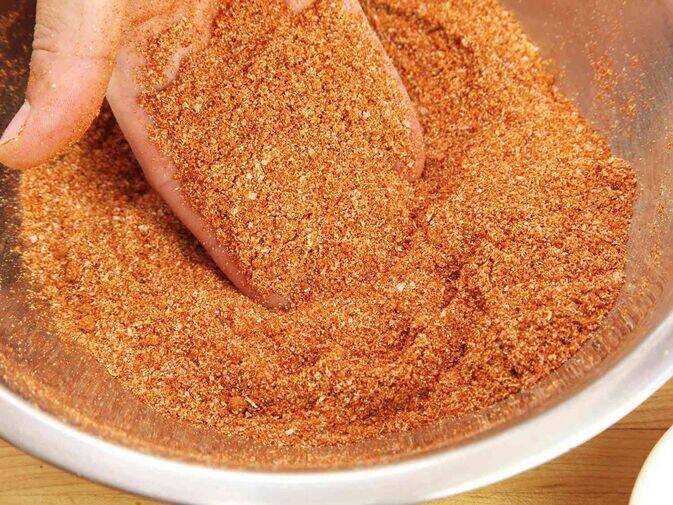
Prepare these ingredients before you begin the marinating and cooking process to streamline your cooking experience.
“Smoke Juice” Marinade
Creating a “Smoke Juice” marinade adds that desirable smoky flavor without a smoker:
- Ingredients:
- 1 cup beef broth — serves as the liquid base.
- 1/2 cup apple cider vinegar — for acidity and tenderization.
- 1/4 cup Worcestershire sauce — deepens the umami flavors.
- 2 tablespoons liquid smoke for brisket — infuses the brisket with a classic smoky taste.
- 2 tablespoons olive oil — helps bind the flavors and coat the meat evenly.
- 3 cloves garlic, minced — for a sharp kick.
- 2 teaspoons smoked paprika — enhances the smokiness.
- Preparation Tips:
- Whisk together all ingredients until fully combined to ensure the flavors meld.
- Marinate the brisket in this mixture for at least 12 hours, turning occasionally to evenly distribute the marinade.
- Keep it covered and refrigerated during marination to maintain freshness and safety.
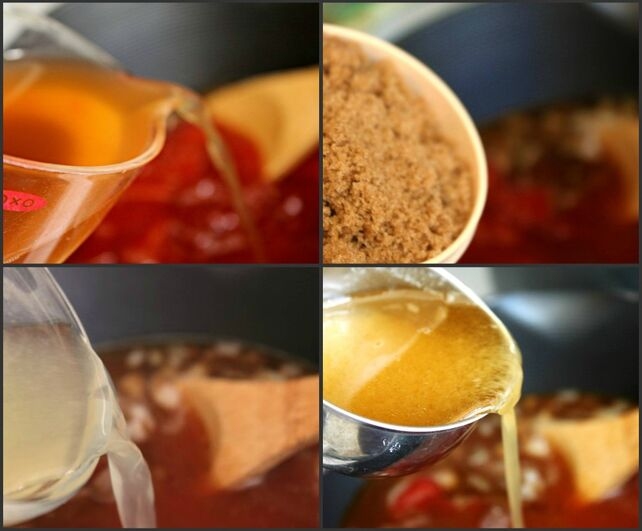
Step-by-Step Instructions
- Prepare the Marinade and Marinate:
- Combine all ingredients for the “Smoke Juice” marinade in a large bowl.
- Place the brisket in a large resealable bag or a deep dish and pour the marinade over it. Ensure the brisket is well-coated.
- Seal the bag or cover the dish and refrigerate. Marinate for at least 12 hours, turning the brisket occasionally to evenly coat with the marinade.
- Apply the Dry Rub:
- Remove the brisket from the marinade and pat it dry with paper towels.
- Mix together all the dry rub ingredients in a bowl.
- Generously apply the dry rub all over the brisket, pressing it into the meat to adhere.
- Preheat the Oven:
- Preheat your oven to 275°F (135°C). This low temperature will allow for slow cooking that tenderizes the brisket.
- Prepare for Oven:
- Place the brisket fat-side up in a roasting pan. Optionally, you can place a rack in the pan to keep the brisket elevated.
- Add a small amount of beef broth to the bottom of the pan to help maintain moisture during the cooking process.
- Cook:
- Cover the pan tightly with aluminum foil or a lid to keep the moisture in.
- Cook in the preheated oven for about 6 hours, or until the brisket reaches an internal temperature of 195°F (90°C). This ensures the connective tissues in the meat break down properly, making it tender and flavorful.
- Rest the Brisket:
- Remove the brisket from the oven and let it rest for at least 30 minutes, still covered. This allows the juices to redistribute throughout the meat, ensuring it remains juicy and tender when sliced.
- Slice and Serve:
- Slice the brisket against the grain into thin slices. This cuts through the muscle fibers, making the brisket easier to chew.
- Serve hot with your favorite sides or incorporate into other dishes.
Preparing the Brisket
Before cooking, proper preparation is crucial for flavor and tenderness:
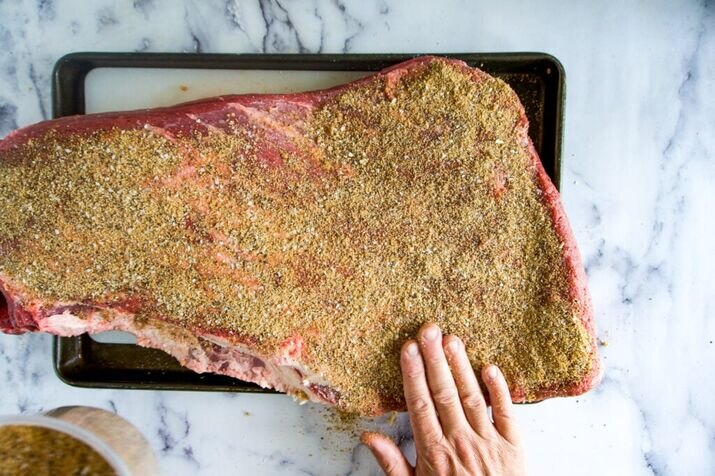
- Trimming: Start by trimming any excess fat from the brisket, leaving about a quarter-inch layer to help keep the meat moist during cooking.
- Applying the Marinade:
- Mix the “Smoke Juice” marinade ingredients thoroughly.
- Place the brisket in a large resealable bag or a deep dish, pour the marinade over it, ensuring it is well-coated.
- Seal the bag or cover the dish and let the brisket marinate in the refrigerator. Marinating should be done for at least 12 hours to allow the flavors to penetrate deeply.
- Adding the Dry Rub:
- After marinating, remove the brisket from the marinade and pat it dry.
- Generously apply the dry rub all over the brisket, pressing the spices into the meat to ensure they adhere and create a flavorful crust.
Oven Cooking Process
Cooking the brisket in the oven requires careful temperature control and timing:
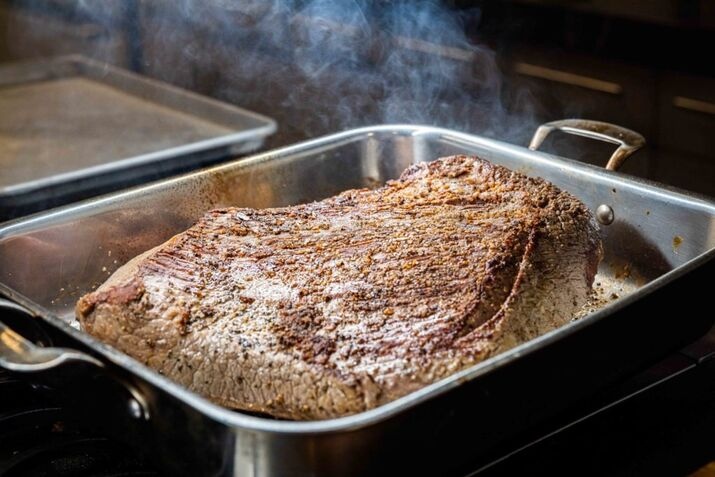
- Preheat the Oven:
- Heat your oven to 275°F (135°C). This low and slow approach helps tenderize the brisket.
- Set Up for Cooking:
- Place the brisket fat-side up in a roasting pan. Using a rack within the pan can help air circulate around the brisket for even cooking.
- Add a couple of cups of beef broth to the pan to help maintain moisture throughout the cooking process.
- Cooking:
- Cover the pan tightly with foil or a lid to trap in moisture and prevent the brisket from drying out.
- Cook the brisket for approximately 6 hours, or until it reaches an internal temperature of 195°F (90°C). The low heat will allow the fat and connective tissue to break down slowly, enhancing tenderness.
- Checking for Doneness:
- Check the brisket by inserting a fork or thermometer to ensure it is tender and reaches the correct internal temperature.
- If the brisket is not tender after the initial cooking time, continue cooking and check every 30 minutes until it reaches the desired tenderness.
Tips for Perfect Oven Brisket
Achieving a mouthwatering brisket in the oven requires a few key techniques. Here are expert tips on how to cook perfect brisket every time:
- Low and Slow is the Way to Go: Cooking your brisket at a low temperature (about 275°F) for an extended period allows the tough connective tissue to break down without drying out the meat. This process ensures your brisket stays juicy and tender.
- Keep It Covered: Use a tightly sealed foil or lid over your roasting pan. This keeps the moisture locked in, which is crucial for a tender brisket.
- Let It Rest: After cooking, let your brisket rest covered for at least 30 minutes before slicing. This allows the juices to redistribute throughout the meat, ensuring every bite is succulent.
- Slice Against the Grain: To ensure the tenderest texture, always slice your brisket against the grain. This cuts through the muscle fibers and makes the meat easier to chew.
- Use a Meat Thermometer: To avoid under or overcooking, use a meat thermometer to check the brisket’s internal temperature, which should reach around 195°F for optimal tenderness.
Serving Suggestions
Once you’ve mastered how to cook the perfect brisket, serving it in a way that enhances its flavors and appeal is key. Here are some ideas to help you serve your brisket, along with side dishes that complement its hearty, smoky essence:
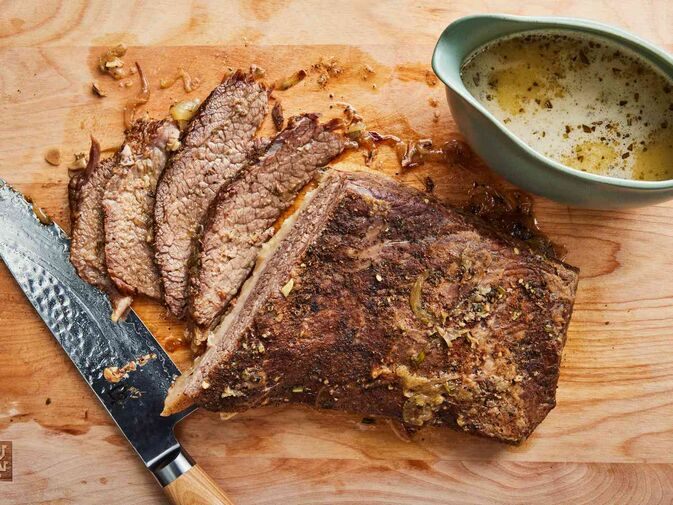
- Slicing: Present your brisket by slicing it thinly against the grain. This not only makes it easier to eat but also shows off the tender, juicy interior.
- Presentation: Serve the brisket on a warm platter. Drizzle a bit of the cooking juices over the slices to add extra moisture and flavor right before serving.
- Vegetable Accompaniments: Offer a balance to the rich brisket with light, refreshing sides like a green salad, roasted vegetables, or a tangy cucumber salad.
- Starchy Sides: Serve hearty sides like mashed potatoes, scalloped potatoes, or a creamy mac and cheese. These dishes are great for soaking up the brisket’s juices.
- Leftovers: If you have leftover brisket, it’s perfect for tacos, nachos, or even added to a hearty chili. These are fantastic ways to enjoy brisket in different forms.
Traditional Sides
When it comes to serving brisket, traditional sides are beloved for good reason—they complement the rich flavors perfectly. Here are some top choices:
- Potatoes: Serve your brisket with a side of creamy mashed potatoes or go for scalloped potatoes layered with cheese and cream for a decadent treat.
- Vegetables: Steamed or roasted vegetables such as carrots, asparagus, or Brussels sprouts offer a light contrast to the rich brisket. Season simply with salt, pepper, and a drizzle of olive oil.
- Bread: Cornbread is a classic choice that pairs wonderfully with brisket, ideal for soaking up any extra juices. Alternatively, serve warm dinner rolls or garlic bread as a comforting side.
Creative Pairing Ideas
To elevate your brisket meal and add an element of surprise, consider these creative serving ideas:
- Brisket Sliders: Mini sliders with slices of brisket topped with onion jam or a quick pickle can be a hit at any gathering.
- Brisket Tacos: Serve brisket in soft tortillas with toppings like fresh cilantro, diced onions, and a splash of lime for a Tex-Mex twist.
- Brisket Poutine: Layer fries with cheese curds and chunks of brisket, then smother in gravy for a hearty Canadian-inspired dish.
- Brisket Pizza: Use thinly sliced brisket as a pizza topping on a homemade or pre-made crust, adding BBQ sauce, red onions, and a blend of cheeses for a delightful twist.
- Asian Fusion: Incorporate brisket into Asian dishes like brisket bao buns or brisket over a bed of stir-fried noodles and vegetables, seasoned with soy sauce and sesame oil.
Storing and Reheating
Proper storage and reheating are crucial to maintaining the quality and flavor of your brisket. Here’s how to do it right:
Storing Brisket
- Cool Down: Allow the brisket to cool to room temperature before storing. However, do not leave it out for more than two hours to avoid bacterial growth.
- Refrigerate Promptly: Wrap the brisket tightly in aluminum foil or plastic wrap, or place it in an airtight container. Store it in the refrigerator where it will keep for up to four days.
- Freezing: For longer storage, brisket can be frozen. Wrap it securely in freezer-safe wrap or vacuum seal it to prevent freezer burn. Frozen brisket can last for up to 3 months. Thaw it in the refrigerator overnight when ready to use.
Reheating Brisket

- Retain Moisture: To keep the brisket moist, add a few tablespoons of broth or water before reheating. This helps to rehydrate the meat and keep it tender.
- Oven Method: Preheat your oven to 325°F (163°C). Place the brisket in a baking dish and cover tightly with foil. Reheat until it reaches an internal temperature of 165°F (74°C), usually about 30 minutes for a sliced brisket.
- Microwave Method: For a quicker option, brisket can be reheated in the microwave. Place slices in a microwave-safe dish, cover with a damp paper towel to maintain moisture, and heat on medium power in short intervals, checking frequently to avoid overheating.
- Stovetop Method: Alternatively, brisket slices can be reheated in a skillet over low heat with a bit of broth or water. Cover the skillet to trap the steam and gently reheat the meat until it’s warm throughout.
- Crock Pot Method: Reheating brisket in crock pot is another easy way, either it is slice or whole. Add a bit of water or broth to keep it moist, close the lid and wait for it till it get warm.
FAQs
Adjusting for Different Oven Types
Cooking brisket in the oven can vary depending on the type of oven you use. Here are tips to ensure you get the best results, whether you have a conventional, convection, or toaster oven:
Conventional Ovens: These are the most common type and typically what recipes refer to. If you’re using a conventional oven, follow the recipe as directed. Keep in mind that these ovens may have hot spots, so rotate your brisket halfway through cooking to ensure even browning.
Convection Ovens: Convection ovens use a fan to circulate hot air around the food, which can speed up the cooking process. When cooking brisket in a convection oven, reduce the cooking temperature by 25°F (about 14°C) from what the recipe suggests, and check the brisket 30 minutes to an hour earlier than the suggested cooking time. This helps prevent overcooking and ensures the brisket remains tender.
Toaster Ovens: While not ideal for large cuts like brisket, a toaster oven can be used for smaller or pre-cut pieces. Due to their smaller size and different heat distribution, reduce the temperature by about 25°F (14°C) compared to conventional ovens and cover the brisket tightly to retain moisture. Cooking times may vary significantly, so monitor the brisket closely to avoid drying it out.
Electric Roaster Ovens: These can be great for brisket due to their ability to maintain consistent low temperatures. Cook the brisket as you would in a conventional oven but keep a closer eye on moisture levels. It may be beneficial to add a little extra liquid to the pan to ensure the brisket doesn’t dry out.
Smart Ovens: If you have a smart oven with preset cooking functions, use the roast setting and adjust according to the oven’s instructions for meat. These ovens often provide precise temperature control, making them excellent for cooking something as sensitive as brisket.
If you’re curious about other cooking methods, don’t miss our article on How to BBQ Brisket on a Gas Grill for expert tips and techniques.
Oven Brisket Recipes
Course: Main DishCuisine: AmericanDifficulty: Intermediate8-10
servings20
minutes300
kcal6
minutesThis oven-cooked brisket recipe delivers tender, flavorful meat through a careful process of marinating and slow-roasting. Perfect for a hearty family meal, it combines rich spices and a touch of smoky essence to satisfy any brisket lover.
Ingredients
1 (10-12 lb) whole beef brisket
1 cup apple cider vinegar
1/2 cup soy sauce
1/4 cup brown sugar
1/4 cup Worcestershire sauce
3 cloves garlic, minced
1 tablespoon smoked paprika
2 teaspoons black pepper
1 teaspoon salt
1/4 cup coarse salt (for the rub)
1/4 cup black pepper (for the rub)
2 tablespoons garlic powder (for the rub)
2 tablespoons onion powder (for the rub)
1 tablespoon chili powder (for the rub)
1 tablespoon mustard powder (for the rub)
2 tablespoons liquid smoke
Directions
- Prepare the Marinade:
In a large mixing bowl, combine the apple cider vinegar, soy sauce, brown sugar, Worcestershire sauce, minced garlic, smoked paprika, black pepper, and salt. Mix thoroughly until the sugar dissolves.
Stir in the liquid smoke to integrate the smoky flavor. - Marinate the Brisket:
Place the brisket in a large resealable plastic bag or a deep baking dish.
Pour the marinade over the brisket, ensuring it is completely covered. Seal the bag or cover the dish.
Refrigerate and allow the brisket to marinate for at least 12 hours, preferably overnight, turning occasionally to ensure even flavoring. - Prepare the Dry Rub:
In a small bowl, combine the coarse salt, black pepper, garlic powder, onion powder, chili powder, and mustard powder.
Remove the brisket from the marinade and pat dry with paper towels.
Rub the spice mixture generously over the entire surface of the brisket, ensuring it is evenly coated. - Preheat the Oven:
Preheat your oven to 275°F (135°C), ensuring it reaches the temperature before cooking. - Prepare for Cooking:
Place the brisket, fat side up, in a large roasting pan. If available, use a rack within the pan to elevate the brisket.
Pour a small amount of beef broth (about 1 cup) into the bottom of the pan to help maintain moisture during the cooking process. - Cook the Brisket:
Cover the pan tightly with aluminum foil or a roasting pan lid.
Place the brisket in the preheated oven and cook for approximately 6 hours, or until the brisket is tender and reaches an internal temperature of 195°F (90°C). - Rest the Brisket:
Remove the brisket from the oven and let it rest, covered, for about 30 minutes. This allows the juices to redistribute throughout the meat, enhancing its flavor and tenderness. - Slice and Serve:
Slice the brisket against the grain into thin slices for serving. This helps to break up the muscle fibers and makes the meat more tender and easier to eat.
Serve warm with your choice of sides.
Recipe Video
Notes
- For a deeper flavor, allow the brisket to marinate overnight in the refrigerator. Ensure the brisket is covered tightly while cooking to retain moisture and tenderize the meat effectively.
Nutrition Information
The following nutrition information is estimated for a serving size of about 3 ounces (85 grams) of cooked brisket:
- Calories: 250-300 kcal
- Protein: 22-25 g
- Total Fat: 15-20 g
- Saturated Fat: 5-7 g
- Trans Fat: 0 g
- Cholesterol: 70-85 mg
- Sodium: 350-500 mg (varies significantly based on the rub and marinade)
- Carbohydrates: 2-5 g
- Dietary Fiber: 0 g
- Sugars: 1-2 g (primarily from the marinade ingredients like brown sugar or honey)
- Vitamins and Minerals:
- Vitamin B12: Significant source due to beef content
- Iron: Good source, important for blood health
- Zinc: Contributes to immune system function
Key Nutritional Benefits:
- Protein-Rich: Brisket is an excellent source of high-quality protein, which is essential for muscle repair and growth.
- B Vitamins: Rich in B vitamins, particularly B12, which helps in the formation of red blood cells and brain function.
- Minerals: Provides essential minerals like iron and zinc, which support immune health and metabolism.
Considerations:
- Fat Content: Brisket is a fatty cut of beef, though much of the fat can be trimmed before cooking. The remaining fat contributes to the flavor and texture of the dish.
- Sodium: The sodium level can be high due to the ingredients used in the marinade and rub. Those monitoring their sodium intake should adjust the amount of added salt or look for low-sodium alternatives in other ingredients like soy sauce.
Connect and Share
We love seeing and hearing about your culinary adventures, especially when it involves a dish as beloved as brisket!
Share Your Tips: Have you discovered a special trick or tweak that makes your brisket unbeatable? Maybe you’ve found the perfect temperature tweak or a marinade ingredient that changes everything.
Post Your Photos: Nothing tells a story quite like a photo. Snap a picture of your finished brisket or document the process and share it with us. Seeing your masterpiece can inspire others and offer real insight into how different techniques and presentations turn out.
Feedback and Suggestions: We’re constantly looking to improve and provide you with the content you find most useful and enjoyable. Let us know what else you’d like to see, whether it’s more recipes like this, detailed guides on other cooking techniques, or something completely different.
We can’t wait to see your creations and hear your stories! Happy cooking, and even happier eating!
Disclosure: Our blog contains affiliate links to products. We may receive a commission for purchases made through these links. However, this does not impact our reviews and comparisons. We try our best to keep things fair and balanced, in order to help you make the best choice for you.

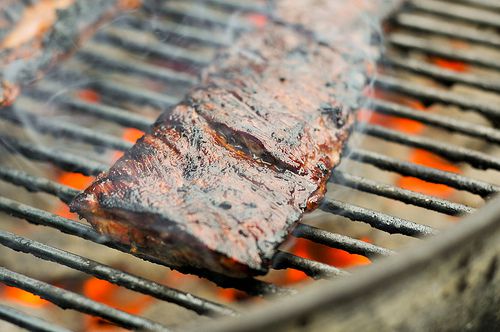

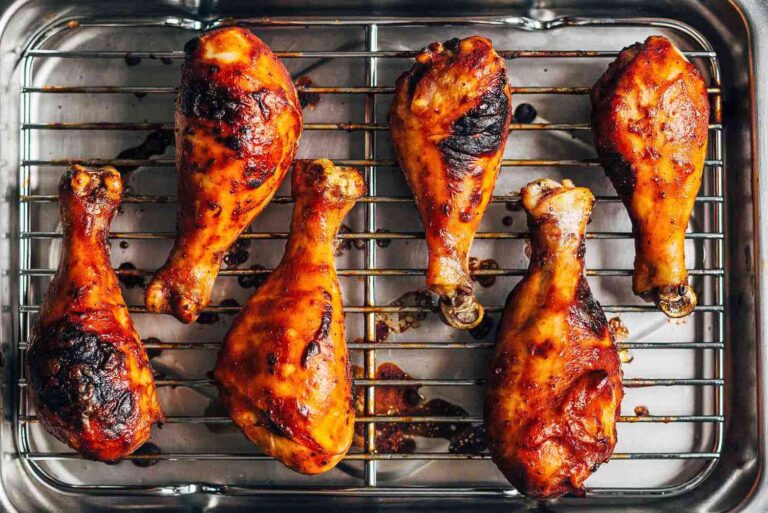
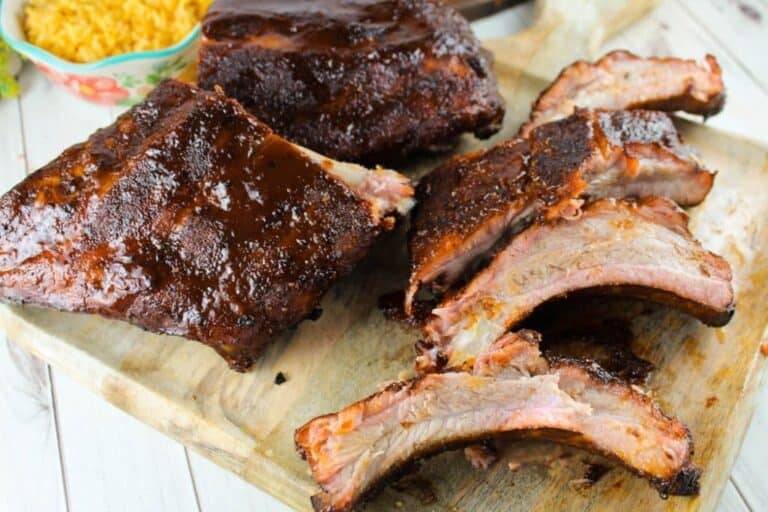
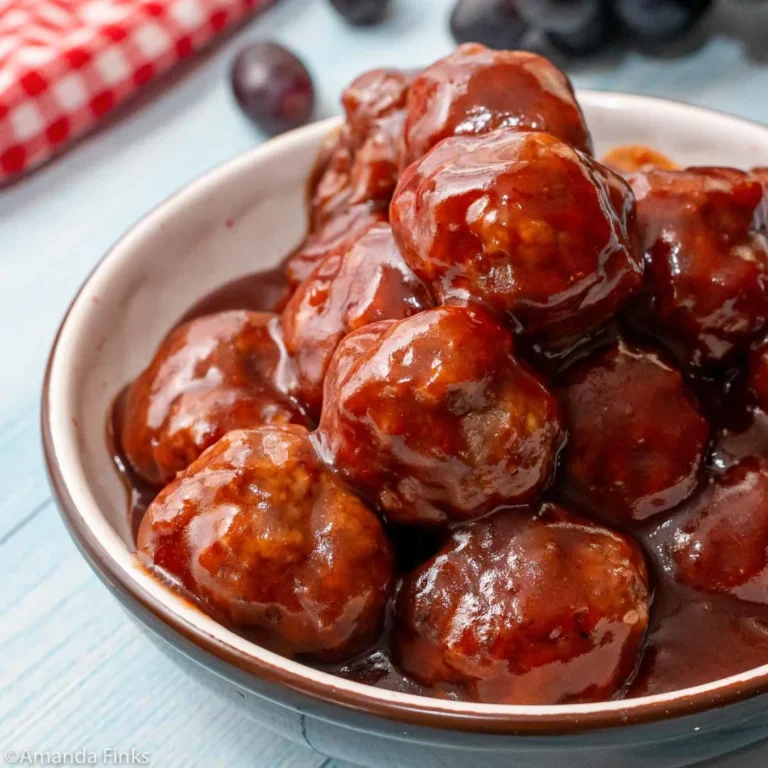
3 Comments